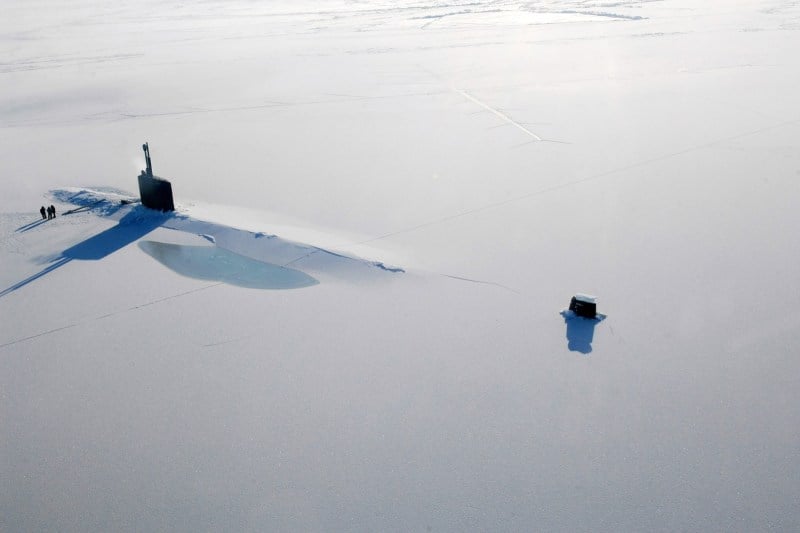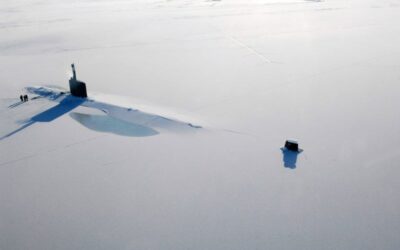American Shipbuilding Needs Allies

American Shipbuilding Needs Allies
If it wants icebreakers, the United States must embrace the role of junior industrial partner.
Tiffini M. Jones/U.S. Navy via Getty Images
Among the slew of executive orders signed by U.S. President Donald Trump in his first 100 days in office is a promise to restore America’s maritime dominance. Resolving the United States’ struggle to efficiently produce naval vessels and its near-complete inability to produce commercial ones is one of the few remaining bipartisan issues in Washington. The 19 specific policy initiatives, backed by a new Office of Maritime and Industrial Capacity at the National Security Council, reflect the magnitude and complexity of such an effort.
Campaigning on shipbuilding since his first presidential run, Trump sees the industry as intrinsic to his trade philosophy. Like many presidents before him, including Joe Biden, Trump has employed trade policy in the name of national security. But he also reverses the process, using national security, especially large defense-industrial projects, to achieve his economic goals, such as reducing trade deficits. When it comes to almost every aspect of the global maritime industry, however, the United States simply does not have the comparative advantages needed for the coercive leverage the president favors.
Among the slew of executive orders signed by U.S. President Donald Trump in his first 100 days in office is a promise to restore America’s maritime dominance. Resolving the United States’ struggle to efficiently produce naval vessels and its near-complete inability to produce commercial ones is one of the few remaining bipartisan issues in Washington. The 19 specific policy initiatives, backed by a new Office of Maritime and Industrial Capacity at the National Security Council, reflect the magnitude and complexity of such an effort.
Campaigning on shipbuilding since his first presidential run, Trump sees the industry as intrinsic to his trade philosophy. Like many presidents before him, including Joe Biden, Trump has employed trade policy in the name of national security. But he also reverses the process, using national security, especially large defense-industrial projects, to achieve his economic goals, such as reducing trade deficits. When it comes to almost every aspect of the global maritime industry, however, the United States simply does not have the comparative advantages needed for the coercive leverage the president favors.
That’s especially true for building icebreakers, a specialized capability the United States embarrassingly lacks. These ships help guarantee U.S. economic security and defend national sovereignty against Russian aggression and a growing Chinese presence in the Arctic. In addition, they ensure access to the valuable energy sources and fisheries in the U.S. exclusive economic zone off Alaska’s coast, whose boundaries are disputed by Russia; support freedom of navigation in increasingly important sea lines of communication in the Arctic and Antarctic; and facilitate scientific research and provide support such as search and rescue for remote but economically important U.S. outposts. A healthy number of modern icebreakers will grow the economy and create jobs far beyond the shipyard.
Trump’s recent, high-profile pledge to build these ships also highlights his conflation of security and trade policy. Canada is one of the very few countries in the world with the industrial know-how to make icebreakers. But the president sandwiched his intention to “order about 40 Coast Guard big icebreakers”—a capability the U.S. Coast Guard desperately needs and has unsuccessfully pursued for decades—between his observations on Canada’s “nasty” trade practices.
International industrial deals such as the Icebreaker Collaboration Effort (ICE) Pact, initiated in 2024 between the United States, Finland, and (as of now) Canada, can still provide large economic and security gains. But they will require the United States playing a role to which it is unaccustomed, and one Trump instinctively loathes: junior industrial partner.
The United States has long used its competitive advantages in building defense-industrial products at scale to extract economic and security gains from its export customers. The F-35 fighter’s 20 international buyers reduce unit prices for the U.S. military while tying these countries into a dense U.S.-led security network. European customers lament the depth of their dependency following the Trump administration’s restriction of Ukrainian F-16 operations, but there is little they can do. U.S. weapons continue to flow into Europe.
As with the F-35, the United States has similarly leveraged its maritime industrial advantages. In its effort to acquire a nuclear-powered submarine capability and the eventual ability to build its own, Australia has committed via the AUKUS agreement to investing $3 billion in U.S. shipyards and has essentially locked itself into the United States’ Indo-Pacific strategy to compete with China.
ICE Pact closely resembles AUKUS, but as an uncanny mirror image. The United States builds world-beating nuclear submarines but has been unable to build a polar-class icebreaker this century. It thus faces the painful trade-offs long familiar to its arms export clients. In the ICE Pact, the United States plays the role of Australia, and it will need to look to Finland and Canada for help in the form of technology, workforce training, and manufacturing capacity. Trump’s executive order posits incentivizing “shipbuilders domiciled in allied nations partner to undertake capital investment in the United States to help strengthen the shipbuilding capacity of the United States.” But every demand for investment, tech transfer, and domestic employment will increase the ultimate sticker price, which is why the United States government lambastes them as market-distorting when they are applied to U.S. defense exports. How should the United States navigate these dilemmas?
First, focus on capability. The most important consideration in an icebreaker deal is not generating jobs or reducing trade deficits but breaking ice. The need is acute. The current fleet consists of the 1970s-era Polar Star and the marginally more spry Healy, which was built in the 1990s and primarily designed to support scientific research. Meanwhile, the commercially procured Storis is still awaiting a refit.
Second, while acquiring the capability is strategically essential, preoccupation with building as much of it as possible in the United States is economically unwise. Trump can surely bring tremendous pressure to bear on Finland and Canada in pursuit of concessions. Indeed, European Central Bank President Christine Lagarde has preemptively urged Europe to buy more U.S. weapons to stave off tariffs. But fixation on narrowing a bilateral trade deficit is a pyrrhic victory if overall U.S. industrial capacity remains competitive in the larger global maritime market. Forty versions of Bollinger Shipyards’ Polar Security Cutter (the first of which might be ready in 2030) amounts to just under a million tons of ship displacement. Such a highly unlikely order size is fifteen years’ worth of U.S. shipbuilding production, but only 1.5 percent of annual global production in 2023. Even if the United States cornered the small and specialized icebreaker market by somehow boxing out niche shipbuilders in Finland and Canada, this would do little to improve broader U.S. shipbuilding competitiveness.
The third principle for such deals can already be found in the executive order: identifying and investing in the “key maritime components in the supply chain that are essential for rebuilding and expanding the Maritime Industrial Base.” The United States should concentrate on acquiring assets and building components with the biggest and broadest economic and security upsides.
Icebreaking technology, while very cool, has little application to other aspects of shipbuilding. Finnish firms excel at developing exquisite technology from asymmetric hull designs and rotating Azipod thrusters. Let them.
Increasing shipyard capacity is certainly desirable, but the United States should not insist on bending the steel for every hull to this end. It’s a relatively low value-added process, and there is massive overcapacity in the world’s shipyards. Washington should instead ensure that the global shipbuilding market remains diversified and competitive. Stymying Chinese domination is more important for U.S. and world economic health than producing a little more at home. Building an industry likely only to expensively acquire a chunk of Japan’s and South Korea’s declining market share will increase China’s market power far more than it would improve the United States’.
By forgoing niche technologies and sharing the production of big but relatively simple components such as hulls, Washington can instead fight for the contracts, technology, and workforce training for the commercial maritime application of high-value sectors in which it already excels: sensing, communications, propulsion, software, and systems engineering. South Korea builds excellent destroyers for considerably less than the price of the U.S. Navy’s Arleigh Burke destroyers, but that is in part because it buys much of the combat, weapons, and propulsion systems from the United States. It is generally a better business proposition to produce the beer rather than the can.
In the unfamiliar position as the trading partner with few sectoral comparative advantages, the United States has much to learn. As a microcosm of the United States’ larger maritime woes, the lessons of icebreakers will go far beyond them. Shipbuilding policy has long been divided by how one feels about the Jones Act. Critics argue that these laws inflate shipping costs for little industrial gain; supporters believe the act is the only thing keeping U.S. commercial shipbuilding from disappearing. But both sides now accept that maritime industrial policy is necessary and in need of massive overhaul. Fixing America’s embarrassing lack of icebreakers through smart international dealmaking, is an opportunity to explore new ideas and approaches. Think of it as a test bed for a broader shipbuilding renaissance that is badly needed.
This post is part of FP’s ongoing coverage of the Trump administration. Follow along here.
Jonathan D. Caverley is a professor at the Naval War College’s Center for Naval Warfare Studies.
Rebecca Pincus is director of the Polar Institute at the Wilson Center.
More from Foreign Policy
-

Eight people dressed in camouflage military combat uniforms wade across a river, the water up to their waists. The soldiers carry large backpacks along with their rifles. Snowcapped mountains and a thick forest of evergreen trees loom in the distance. Get Ready for the Aleutian Island Crisis
As conflict heats up in the Arctic, foreign adversaries eye Alaskan territory.
-

U.S. President Donald Trump speaks to reporters before boarding Air Force One at Morristown Municipal Airport in Morristown, New Jersey, on April 27. Trump’s First 100 Days Reveal a ‘Strongman’s’ Unprecedented Weakness
No U.S. president has ever surrendered global power so quickly.
-

An elderly man and woman sit on the ground, the man on his knees as he sorts through something on the ground. Behind him are a rusted cart and bicycle in front of a paint-smeared concrete wall and a battered corrugated metal sign with the words USAID: From the American people” on it. What Trump’s New Budget Says About U.S. Foreign Policy
The president wants to significantly pull back on many of America’s traditional global engagements while spending more on the border and defense.
-

U.S. President Donald Trump listens to Secretary of State Marco Rubio at a cabinet meeting in the White House in Washington, D.C. Rubio’s Reorganization Plan Is a Wrecking Ball
The State Department revamp goes far beyond streamlining—it will devalue human rights and strip away critical expertise.










Join the Conversation
Commenting on this and other recent articles is just one benefit of a Foreign Policy subscription.
Already a subscriber?
.
Subscribe
Subscribe
View Comments
Join the Conversation
Join the conversation on this and other recent Foreign Policy articles when you subscribe now.
Subscribe
Subscribe
Not your account?
View Comments
Join the Conversation
Please follow our comment guidelines, stay on topic, and be civil, courteous, and respectful of others’ beliefs.
Change your username |
Log out
Change your username:
CANCEL
Confirm your username to get started.
The default username below has been generated using the first name and last initial on your FP subscriber account. Usernames may be updated at any time and must not contain inappropriate or offensive language.